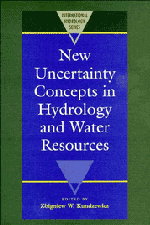Book contents
- Frontmatter
- Contents
- List of Authors
- Preface
- I INTRODUCTION
- II FACETS OF UNCERTAINTY
- III NOVEL APPROACHES TO UNCERTAINTY: FRACTALS, FUZZY SETS AND PATTERN RECOGNITION, NON-PARAMETRIC METHODS
- IV RANDOM FIELDS
- 1 Analysis of regional drought characteristics with empirical orthogonal functions
- 2 Worth of radar data in real-time prediction of mean areal rainfall by nonadvective physically-based models
- 3 Uncertainty analysis in radar-rainfall estimation
- 4 Design of groundwater monitoring networks for landfills
- 5 Spatial variability of evaporation from the land surface – random initial conditions
- 6 Detecting outliers in flood data with geostatistical methods
- V TIME SERIES AND STOCHASTIC PROCESSES
- VI RISK, RELIABILITY AND RELATED CRITERIA
3 - Uncertainty analysis in radar-rainfall estimation
Published online by Cambridge University Press: 07 May 2010
- Frontmatter
- Contents
- List of Authors
- Preface
- I INTRODUCTION
- II FACETS OF UNCERTAINTY
- III NOVEL APPROACHES TO UNCERTAINTY: FRACTALS, FUZZY SETS AND PATTERN RECOGNITION, NON-PARAMETRIC METHODS
- IV RANDOM FIELDS
- 1 Analysis of regional drought characteristics with empirical orthogonal functions
- 2 Worth of radar data in real-time prediction of mean areal rainfall by nonadvective physically-based models
- 3 Uncertainty analysis in radar-rainfall estimation
- 4 Design of groundwater monitoring networks for landfills
- 5 Spatial variability of evaporation from the land surface – random initial conditions
- 6 Detecting outliers in flood data with geostatistical methods
- V TIME SERIES AND STOCHASTIC PROCESSES
- VI RISK, RELIABILITY AND RELATED CRITERIA
Summary
ABSTRACT Two Monte Carlo simulation experiments which address the problem of radar-rainfall estimation are presented. One of the problems associated with hydrologic use of radar-rainfall data is the need to adjust radar rainfall estimates to raingage estimates. The adjustment, which is performed in real time, can be done in the mean field sense. The problem of development of such an adjustment scheme is difficult due to largely unknown statistical structure of radar errors and the fundamental sampling differences between these two sensors. To investigate the problem, mean field bias is modeled as a random process that varies not only from storm to storm but also over the course of a storm. State estimates of mean field bias are based on hourly rain gage data and hourly accumulations of radar rainfall estimates. The procedures are developed for the precipitation processing system to be used with products of the Next Generation Weather Radar (NEXRAD) system. To implement the state estimation procedure parameters of the bias model must be specified. The performance of the state estimation is investigated within a Monte Carlo simulation framework. The results highlight the dependence of the state estimation problem on the parameter estimation problem. The second experiment addresses the problem of converting radar-measured reflectivity into rainfall rate. This is typically done using a Z–R relationship. The parameters of such relationship can be estimated using climatological data and nonparametric estimation framework. In the paper the effects of thresholds imposed on the observations included in the estimation are investigated.
- Type
- Chapter
- Information
- New Uncertainty Concepts in Hydrology and Water Resources , pp. 181 - 189Publisher: Cambridge University PressPrint publication year: 1995
- 1
- Cited by

